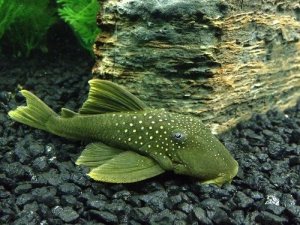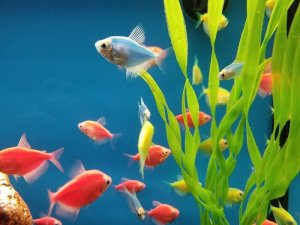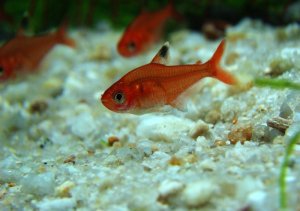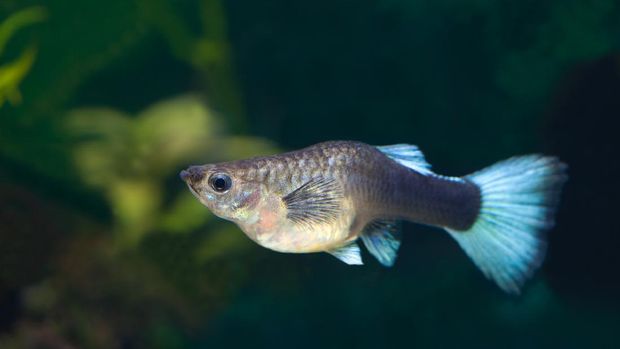
Many individuals fall in love with the idea or even watch their aquarium fish giving birth to tiny babies (fry). It can be especially interesting to watch aquarium fish give birth, and there are similarly more benefits to birthed fry than hatched fry.
Thus, we will be referring to them as live-bearing fish, and will take some time to explore some of the top listed fish that give Live Birth, and why they are so prized.
Do Fish Give Live Birth?
Most freshwater fish species lay eggs to reproduce, however, did you know that there are many Freshwater fish that similarly give birth to live young, thus called live bearing? Essentially, live-bearing aquarium fish will retain their eggs inside their body, eventually give birth to live, and free-swimming young fish, referred to as “fry”.
Almost all the aquarium fish species that are members of the Poeciliidae family are live-bearing, with some other unusual livebearers such as the seahorse, and pipefish, included as well as some cichlids that are called mouthbrooders (incubate their eggs in their mouth)
Benefits Of Live Bearing For Fish
Fish that give live birth to their young have a more effective survival strategy and much less responsibility than fish that lay eggs. Here are a few reasons why:
- Livebearer fry is usually born larger and less fragile, in comparison to frying born from eggs. They can eat a variety of foods from birth and are; ready and well equipped to escape predators.
- Adult fish that do not lay eggs do not need to pair up and guard their eggs, such as other fish species. The females have much more freedom to explore and get enough to eat.
- Females similarly use less energy to give birth than laying thousands of eggs at a time, hoping that a few will hatch and survive.
- Most live-bearing fish are inexhaustible breeders and are capable of quickly populating a body of water, especially Guppies known as some of the fastest and most excessive live-bearing breeders.
What Fish Give Live Birth?
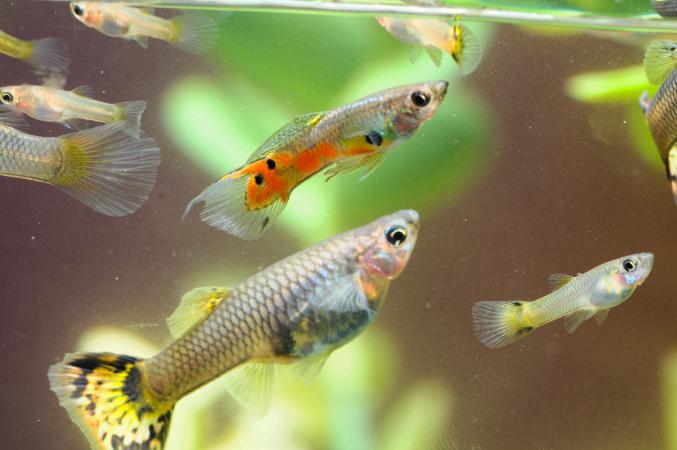
Fish that give live birth are designated to two groups, those that are ovoviviparous, and those that are viviparous. Ovoviviparous fish mostly consisting of the Poeciliidae family form the largest group and are called so because eggs are retained in the body of the fish and are independent of the mother. Whereas viviparous fish have eggs that receive nutrition from the mother’s blood supply through structures in her placenta. Mostly marine species such as sharks, whales, and dolphins are viviparous, among a few freshwater fish that we will discuss.
There are a few popular viviparous freshwater fish species:
- Bowstripe Barbs
- Eelpouts
- Split Fins
- Halfbeaks
- Pipefish
- Rainbow characodons
- Killifish
- Tiger Teddy (Neoheterandria elegans)
Ovoviviparous fish species are more popular and attainable in the freshwater aquarium hobby:
- Mollies
- Platys
- Endler’s livebearers
- Swordfish
- Guppies
- Limia
- Mosquitofish
Sexing live-Bearing Fish
One main aspect about live-bearing fish, especially those that are ovoviviparous, is that it is quite easy to tell what gender they are.
The best way to tell the gender is by looking at the gonopodium (the anterior portion of the anal fin of male fish) which will have a longer, and more spiky appearance, whereas females only have a regular triangular anal fin.
Here are a few interesting facts on male and female live-bearing fish:
- Male Swordtail fish species have a sword-like tail fin, and male sailfin mollies have a large dorsal fin resembling a sail, which the females lack.
- Male guppies are much brighter and more vivid in color than females which may seem dull, and similarly, males have a larger flowing tail.
- Most male live-bearing fish are known to “live fast and die young” because all they do is eat and breed, usually harassing females relentlessly.
- Many times Guppy females are most likely already pregnant when you purchase them from a pet store.
- Female swordtails can change their gender and develop a male gonopodium, and eventually the sword-shaped tail.
- Most Livebearng fish will not shoal together, however, they usually live together in a few numbers in the wild and enjoy the company of their kind.
Before we go further, one extremely important factor that pertains to most live-bearing fish is that they are kept in groups with a specific male and female ratio. Ideally, this is done to prevent males from fighting and to give females a break from being chased after by males constantly. The most effective recommended ratio as you will see from many sources is usually (1:3) 1 male to 3 females, in some cases 2 males and four females.
General Tank Setup For Livebearers
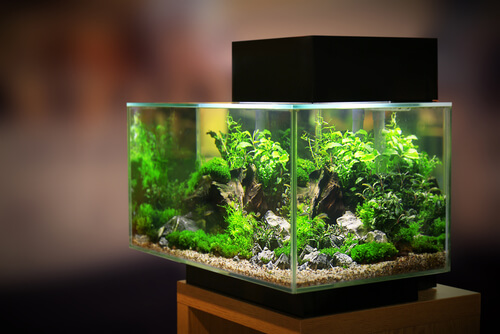
Before we can get into live-bearing fish species, I would like to go over their basic requirements as per conclusions taken from trusted sources on each of the five species. I have added specific parameters for water conditions, and extra facts per species, however generally, most of the chosen live-bearing fish have similar needs in terms of their habitat;
- Substrate – Substrates such as fine gravel, sand, and small pebbles are suitable, especially if you keep rooted plants.
- Décor – A few good hiding spots such as caves, shipwrecks, or rock formations, and some driftwood are ideal for entertainment and resting.
- Plants – You can choose from live or synthetic plants, though live plants are usually recommended for their nutritional and water-cleaning benefits. A few beginner-friendly live plants include;
- Floating Water Lettuce, Water Sprites, Amazon Frogbit.
- Long Stemmed Pennywort, Bolbitis, and Water Wisteria.
- Java ferns, Cryptocoryne, Anubias, and Amazon Swords.
- Moss such as Java Moss, Marimo Moss Balls, and Crystalwort.
- Heater – You will need a suitable heater depending on the size of your tank, as most live-bearing freshwater fish may prefer warmer temperatures, especially in cold climates.
- Filter – A suitable under gravel or hang-on back filter is required to keep the water clean and well-oxygenated. You can look at the requirements of each specific live-bearing fish to determine whether they like a moderate or low current.
If you are planning on breeding with any of the live-bearing fish species from our list, it is highly recommended that you invest in a separate breeding tank, as many of these fish have cannibalistic tendencies towards their own young or that of other fish species in a communal tank.
The Breeding tank will have a much similar set-up, however, you should plant it much more densely and include ample hiding spaces for females and fry. A bare-bottom tank is preferred by many breeders as it is much easier to clean. The size will depend on the fish species, as with the water parameters.
Most Popular Live-Bearing Fish Species
So, after all the introductions we finally get to our top five Live-bearing Fish species, which are all Ovoviviparous. As they are the most popular in the aquarium trade.
1. Guppies
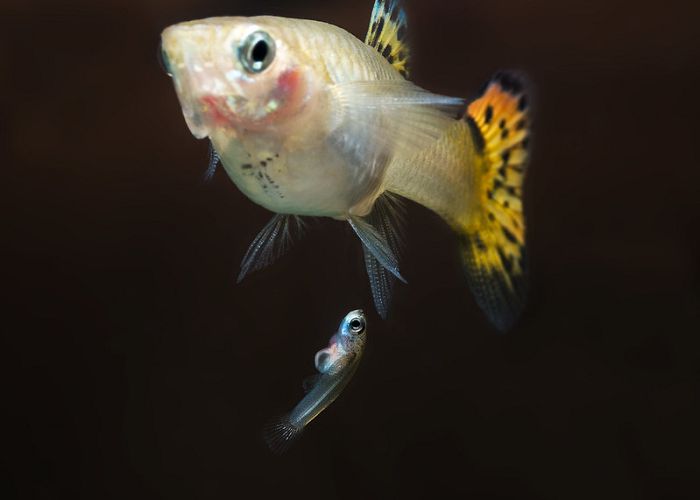
The Guppy, scientifically named Poecilia Reticulata, is often referred to as the Millionfish because of how fast it reproduces. Guppies originate from South America and are one of the most popular freshwater aquarium fish species. Their average sizes are 1.5–3.5 cm (0.6–1.4 in) in males, and females are 3–6 cm (1.2–2.4 in).
- General Care – It is recommended to keep guppies in groups of at least one male and three females, for which you will need a 10 to 20-gallon tank for the rate at which they reproduce. They prefer more brackish and hard water parameters with temperatures around 2 and 27.8 °C (72 and 82 °F) and a pH of 7.0-8.0.
- Feeding – Guppies are quite active and require regular feeding of at least 3 meals a day. They are Omnivores enjoying quality flake or pellet fish food, along with freeze-dried or live Bloodworms, brine Shrimp, and blanched shredded green vegetables such as zucchini, lettuce, and spinach.
- Breeding And Birth Process – Guppy females are polyandrous and may mate with multiple males. They will choose the brightest colored male, or a male that they have witnessed attending to other females. They have a gestation period of around 20 to 60 days and require slightly higher temperatures during this time. Female guppies can store sperm in their ovaries even long after the death of the male guppy. The female will give birth dropping individual fry up to 200 at a time, throughout one to six hours, sequentially.
- Caring For The Fry – Most well-fed adult guppies will not eat their young, but it remains a risk. Thus in a well-planted communal tank without other predators, they may be fine, otherwise, a breeding tank may be needed. Young fry can be fed baby brine shrimp and daphnia until they become more mature.
2. Black Mollies
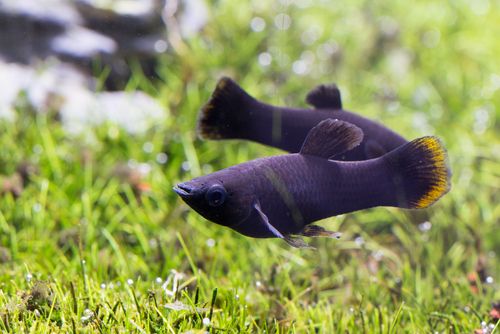
The Black Molly is similar to the Poecilia species Poecilia Sphenops and forms part of the common short-fin molly that is found in many other colors. An adult Molly is around 3.2 inches, or 8 cm, for males, and 4.8 inches, or 12 cm for females. They. have a longer lifespan of approximately 3 to 4 years. The Black Molly, or Molly in general is similarly an Ovoviviparous live-bearing fish that is native to South America.
- General Care – Mollies similarly need to be kept in a one-male-to-three-female ratio, and they make excellent tank mates in a communal aquarium, though they tend to be slightly nippy towards long-finned fish that are slow swimming. Mollies similar to guppies need brackish water enhanced with salt to survive. They prefer water temperatures of around 75-80°F (24-27°C) and a pH of between 7.5 and 8.5. A 15-gallon tank is suitable for 3 mollies, however much larger will be needed for breeding and additional tank mates.
- Feeding – Mollies are Omnivores and should be fed a staple of flaked and dried fish food, with additional proteins such as Bloodworms, Daphnia, and microforms. Blanched and shredded vegetables such as cucumber, broccoli, green beans, lettuce, zucchini, and carrots can be given. They even enjoy chicken, egg yolk, and minced beef at times. Mollies are easy to feed as they will not overeat and spit up their food when they have had enough.
- Breeding And Birth Process – Mollies are similar in their mating rituals and breeding tactics to guppies. Females similarly choose the boldest colored male and can store sperm months after mating. Mollies unfortunately are not good parents and will eat their own young and that of other species. It is vital to remove the male after mating and keep the female in a breeding tank. During birth, the mother will quiver with contractions and stay in a stationary position. Fry is born in a curled-up position because they are relatively large in comparison.
- Caring For The Fry – The female can be removed once the fry is born to protect them. Young fry can be fed powdered fish flakes, ground-up blood worms, and brine shrimp.
3. Swordtails
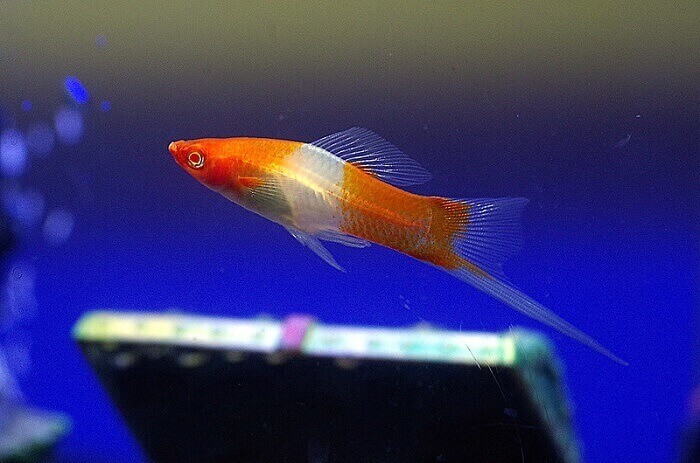
The Swordtail, Poecilia Xiphophorus, is a freshwater fish native to Mexico and Northern Central America with the Green Swordtail species being the most popular. Swordtails are livebearers that use internal fertilization and are similarly Ovoviviparous. They are a larger species ranging from 14 centimeters (5.5 in) in males, and 16 centimeters (6.3 in) in females. The males have a prominent longer sword shape on their tails that the females lack.
- General Care – Swordtails are quite similar to Guppies and Mollies requiring brackish water conditions, however, contrary prefer soft water with a stronger current. They are very adaptable with temperature ranges of 64°F to 82°F (17°C and 27°C), and a pH between 7.0 and 8.0. They are peaceful community fish and can be hybridized with Platys and vice versa, however, you still need to stick to the stick one male per three females regimen.
- Feeding – Swordtails are omnivores enjoying a diet with varied blanched and sliced vegetables, meat-based foods such as tubifex worms, brine shrimp, and daphnia, as well as a staple quality fish flaked or pelleted food. They may eat from your hand, and require two meals per day.
- Breeding And Birth Process – Swordtails are easy to breed and will regularly interbreed with other species of the poeciliid family in a community tank, thus you may want to separate them to keep the same species. Swordfish can be kept in pairs, and females will likely be attracted to males with larger tail fins. You can condition your breeding pair in a separate tank and feed them a more protein-rich diet. After mating the female can also hold sperm for a few months. The gestation period is between 28 – and 40 days.
- Caring For The Fry – After the female has given birth though, it is advised to separate her from the fry and place her in a separate or safe tank to recover. Fry can be from small amounts of flaked foods and baby brine shrimp.
4. Platies
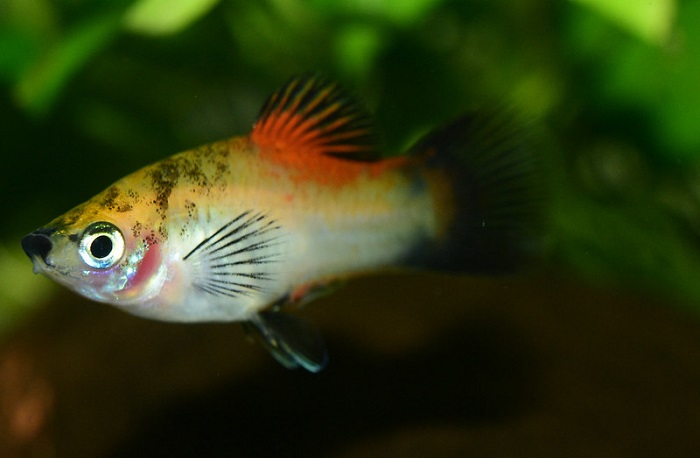
Platies and Swordfish are close relatives, being from the genus Xiphophorus, and the Poeciliidae family, however, they lack the actual “sword” tail. Platies are native to the East Coast of Central America and Southern Mexico. They will reach sizes of around 7.0cm (2.8) inches, with males relatively similar in size to females.
- General Care – It is highly advised to keep Platies in groups of three to six, with a 1:3 ratio of males and females as males constantly harass females to mate. With good water parameters, Platys can live for up to 3 years in a 10 to 20-gallon tank. They prefer water temperatures of around 72 to 82 °F (22 to 28 °C), and a pH of between 7.0 and 8.0
- Feeding – They are undemanding Omnivores that will devour almost anything and should only be fed a small amount of food several times a day. You can feed them quality fish food, meats such as Brine Shrimp, Blood worms, and even chicken or ground beef. They also enjoy most vegetables that are blanched and shredded.
- Breeding And Birth Process – Unfortunately adult Platys are cannibalistic and do not care much for their fry, thus to survive they will need a well-planted communal tank with plenty of hiding spaces, or even better, a separate breeding tank. Males and females Platys require no encouragement to mate. The female will have a dark spot in her belly if she is pregnant and will give birth within 24 to 30 days. Ideally, the female can be placed in the breeding tank when pregnant until after she has given birth, or you can wait for the fry, and transfer them to the breeding tank.
- Caring For The Fry – Ideally, there should be around 20 to 80 fry born, and most should survive. They can be fed quality fish food, or baby brine Shrimp as a starter food. It will however be safer for them to remain in a separate tank until they are more mature.
5. Endler’s livebearers
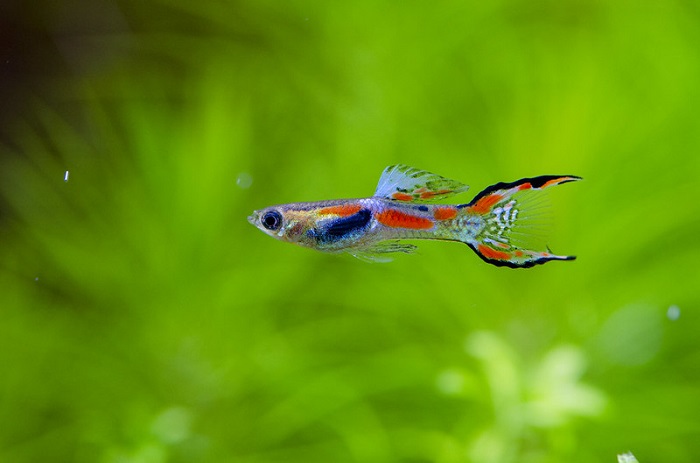
Saving the best for last, the Endler’s livebearer is also a type of Guppy, known as the Poecilia Wingei, with much more vivid colors, and native to the Paria Peninsula in Venezuela. They are stunning, to say the least, with distinct colors, and many visual differences between males and females, making them ideal to breed. Endler’s Guppies can reach sizes of 4.5cm (2 inches) in females and are much smaller at 2.5cm (1 inch) in males. Females generally live longer than males who live a maximum of 2 years.
- General Care – Endler Guppies are peaceful communal fish and schooling fish that are delightful to watch in their shimmering colors. Because they are such prolific breeders it is advised to keep one male per two or three females, to give the females a break. They thrive in space so a 10 to 15-gallon tank will be advised for a school of them, that is well-planted with plenty of hiding spaces. Water temperatures between 5.5 and (78 and 82 °F) 16. 6 °C and 27.8 °C (64°F – 82°F), offer a tolerable range, however, 25. 5 °C (78°F) is most comfortable for them with a pH of between 7.0 and 8.0. It must be said though that they are not like guppies in terms of preference to salty, brackish water, and they prefer fresh water.
- Feeding – Endlers are Omnivores feeding on algae, plant matter, and insects in the wild. You can feed quality fish food suitable for guppies along with frozen or freeze-dried worms, shrimp, and blanched vegetables.
- Breeding And Birth Process – Males and females will easily mate when placed in the same tank, with many similar rituals to that of Guppies. Good advice would be to separate the pregnant female into a breeding tank so that she can endure pregnancy and birth in peace. You will notice a dark spot on the female if she is pregnant, which will become darker as the pregnancy progresses. Gestation takes around a month or so, and the female generally gives birth to 20 or 30 fry. The labor process can take up to 12 hours, so be ready! In a situation where she is in a communal tank, you can place her in a safe and relaxed breeding box during birth.
- Caring For The Fry – Endler’s Guppies rarely eat their young as opposed to Guppies, however, they do not provide much parental care. You can supplement the fry with baby brine shrimp and finely crushed flaked foods three times a day. Keep the water clean and try to do water changes every three days.
To Conclude:
As we have journeyed through the list of popular live-bearing aquarium fish, you may have noticed that there are many similarities between them. Most are prolific breeders that may breed in a communal tank whether you want them to or not, and some are cannibalistic towards young fry, which in some cases keeps the population down. So to successfully breed any of these species, it is advised to have a separate tank, especially in a mixed communal tank.


